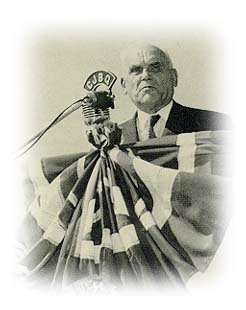They are counter productive. Modern capitalism requires government to spend on infrastructure in order to function as this analysis by Michael Hudson points out.
The logic of public investment is to upgrade economies and make them more competitive
Nations that today have the highest incomes recognize that rising productivity should enable costs and prices to fall – and that public investment is needed for this to occur. U.S. development strategy was based explicitly on public infrastructure investment and education. The aim was not to make a profit or use its natural monopoly position to extract economic rent like a private company would do. It was to subsidize the cost of living and doing business – to make the economy more efficient, lower-cost and ultimately more fulfilling to live and work in.
At issue is the idea that capital investment is inherently private in character. The national income and product accounts do not recognize government investment even in infrastructure, to say nothing of subsidies for the research and development that led to much space and aeronautics technology, information-processing and the internet, pharmaceuticals, DNA biology and other sectors that enabled private companies to make hundreds of billions of dollars.
Simon Patten, the first professor of economics at the nation’s first business school – the Wharton School at the University of Pennsylvania – explained that the return to public investment should not take the form of maximizing user fees. The aim was not to make a profit, but just the reverse: Unlike military levies (a pure burden to taxpayers), “in an industrial society the object of taxation is to increase industrial prosperity”[7] by lowering the cost of doing business, thus making the economy more competitive. Market transactions meanwhile would be regulated to keep prices in line with actual production costs so as to prevent financial operators from extracting “fictitious” watered costs – what the classical economists defined as unearned income (“economic rent”).
The U.S. Government increased prosperity by infrastructure investment in canals and railroads, a postal service and public education as a “fourth” factor of production alongside labor, land and capital. Taxes would be “burdenless,” Patten explained, if invested in public investment in internal improvements, headed by transportation infrastructure.
“The Erie Canal keeps down railroad rates, and takes from local producers in the East their rent of situation. Notice, for example, the fall in the price of [upstate New York] farms through western competition” making low-priced crops available from the West.[8] Likewise, public urban transport would minimize property prices (and hence economic rents) in the center of cities relative to their outlying periphery.
Under a regime of “burdenless taxation” the return on public investment would aim at lowering the economy’s overall price structure to “promote general prosperity.” This meant that governments should operate natural monopolies directly, or at least regulate them. “Parks, sewers and schools improve the health and intelligence of all classes of producers, and thus enable them to produce more cheaply, and to compete more successfully in other markets.” Patten concluded: “If the courts, post office, parks, gas and water works, street, river and harbor improvements, and other public works do not increase the prosperity of society they should not be conducted by the State. Like all private enterprises they should yield a surplus” for the overall economy, but not be treated as what today is called a profit center (loc. cit.).
Public infrastructure represents the largest capital expenditure in almost every country, yet little trace of its economic role appears in today’s national income and product accounts. Free market ideology treats public spending as deadweight, and counts infrastructure spending as part of the deficit, not as productive capital investment. The only returns recognized are user fees, not what is saved from private operators incurring interest charges, dividends, other financial fees, as well as high executive salaries.
As Patten showed, the relatively narrow scope of “free market” marginal productivity models applies only to private-sector industrial investment, not to public investment. (What would the “product” be?) The virtue of this line of analysis is to point out that the alternative is to promote a rentier “tollbooth” economy enabling private owners of infrastructure or other monopolies to charge more than the “marginal product” actually costs. Stock and bond markets increasingly aim at extracting economic rent rather than earning profits by investing in tangible capital formation to employ labor to increase output, not to speak of rising living standards.
In the United States, Alaska and Wyoming pay their residents a “citizens’ dividend” out of their resource rent receipts. Alaska’s Senators Stevens and Murkowski, as well as its Governor Sarah Palin, did not believe that it is proper for government to upgrade, educate and provide the population with social services. So Alaska has used its oil revenue to pay each resident a few thousand dollars – and to abolish property taxes. This policy leaves Alaska among the lowest-ranking states in terms of literacy, education, support for the arts and technology, while avoiding progressive taxation.
The state’s neoliberal anti-tax, anti-government ideology condemns its residents to send their children out to work rather than educating them and investing in their improvement.
It is a bankers’-eye view of the world, not that by which Britain, France, Germany and the United States built themselves up to global leadership positions. The focus is on financial returns, not on lowering the cost of living and production or upgrading the quality of work. It views government spending as a deadweight cost, not as productive investment.


![[fight1.gif]](https://blogger.googleusercontent.com/img/b/R29vZ2xl/AVvXsEhsJbD6v55p8v5khNmr6Nm6a5MEvtYMgQN_CXShXNXXoNb6ooqeGj-9o7ogg6FQHj1k6Tv4P_c8R952C7PXaK6D-rBLGEIdzbmWlAIynoky3gwHPoX7qfOzKqRbRwXKGmfHrFVaow/s1600/fight1.gif)
